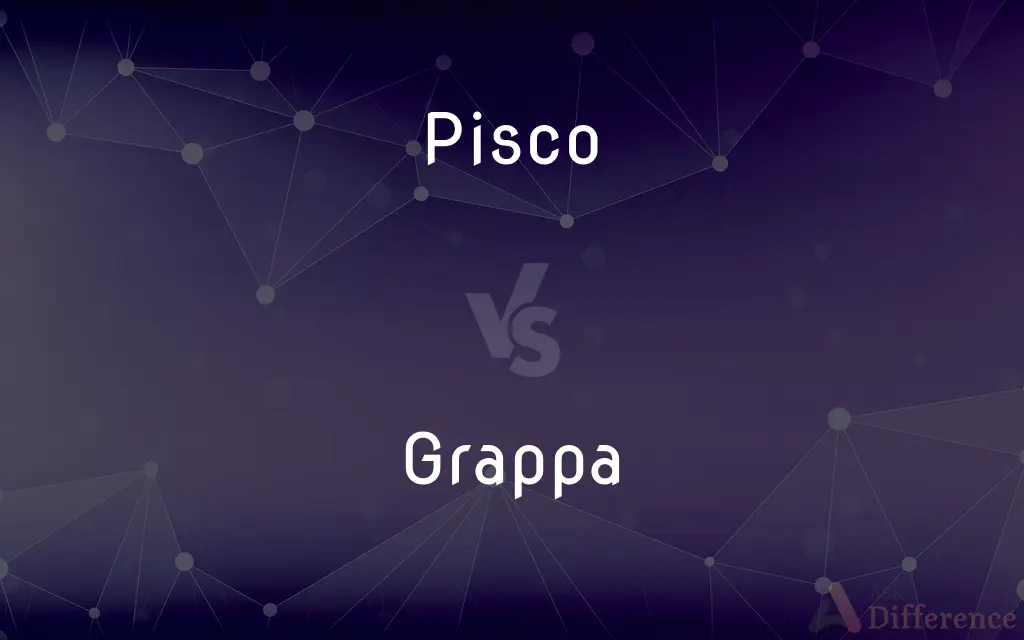Pisco vs. Grappa — What's the Difference?
By Tayyaba Rehman — Updated on October 25, 2023
Pisco is a grape brandy from South America, while Grappa is an Italian brandy made from grape pomace.

Difference Between Pisco and Grappa
Table of Contents
ADVERTISEMENT
Key Differences
Pisco is a distilled spirit that originates from Peru and Chile. It is made by fermenting grape juice into wine and then distilling the wine into a high-proof spirit. Grappa, on the other hand, originates from Italy and is made by distilling the leftover grape pomace (skins, seeds, and stems) after the winemaking process.
Both Pisco and Grappa hold distinct positions in the cultures of their origin. While Pisco is celebrated with the Pisco Sour cocktail, Grappa is often sipped as a digestif after meals. Each spirit offers a unique taste profile, with Pisco typically being smoother and fruitier, and Grappa showcasing a stronger, more robust flavor due to the pomace.
The production methods of Pisco and Grappa differ significantly. Pisco is produced by distilling fermented grape juice, which ensures its clear, pure quality. In contrast, Grappa's distinct taste comes from the distillation of grape residues, giving it a more rustic flavor.
Pisco and Grappa, though both are grape-derived spirits, have different geographic denominations. Pisco can only be called so if produced in specific regions of Peru or Chile. Grappa, however, is strictly an Italian spirit, with its production and name protected under Italian law.
Comparison Chart
Origin
South America (Peru and Chile)
Italy
ADVERTISEMENT
Made From
Fermented grape juice
Grape pomace (skins, seeds, stems)
Flavor Profile
Smoother and fruitier
Robust and rustic
Typical Use
Often used in cocktails like Pisco Sour
Typically sipped as a digestif
Geographical Denomination
Specific regions in Peru and Chile
Protected under Italian law
Compare with Definitions
Pisco
Pisco can be both aromatic and non-aromatic.
I prefer aromatic Pisco for its distinct flavor.
Grappa
Grappa is an Italian brandy made from grape pomace.
After dinner, would you like some Grappa?
Pisco
Pisco holds a cultural significance in South American celebrations.
Pisco is the star during our national festivities.
Grappa
Grappa is distilled from the residues of winemaking.
Grappa captures the essence of the entire grape, even the leftovers.
Pisco
Pisco is primarily produced in Peru and Chile.
This Pisco is from a renowned distillery in Peru.
Grappa
Grappa production is protected under Italian law.
True Grappa can only be produced in Italy.
Pisco
Pisco is a grape-derived spirit from South America.
Would you like a Pisco Sour cocktail?
Grappa
Grappa often has a robust and rustic flavor.
This Grappa has a strong character, revealing its origin.
Pisco
Pisco is distilled from fermented grape juice.
The purity of Pisco comes from distilling grape juice.
Grappa
Grappa is an alcoholic beverage: a fragrant, grape-based pomace brandy of Italian origin that contains 35 to 60 percent alcohol by volume (70 to 120 US proof). Grappa is traditionally produced in Northern Italy and is also widely consumed in places such as Argentina, Bulgaria, Georgia (Chacha (brandy)), Uruguay and Galicia (better known as Spanish orujo or aguardiente).
Pisco
Pisco is a colorless or yellowish-to-amber colored brandy produced in winemaking regions of Peru and Chile. Made by distilling fermented grape juice into a high-proof spirit, it was developed by 16th-century Spanish settlers as an alternative to orujo, a pomace brandy that was being imported from Spain.
Grappa
A brandy distilled from the fermented residue of grapes after they have been pressed in winemaking.
Pisco
A liquor distilled from grapes (a brandy) made in wine-producing regions of Peru and Chile. It is the most widely consumed spirit in Argentina, Bolivia, Chile and Peru.
Grappa
An Italian brandy distilled from the pomace of grapes used in winemaking.
Grappa
(uncountable) An Italian grape-based spirit of between 80 and 100 proof, made from the distillation of pomace.
Grappa
(countable) A variety or serving of grappa.
Grappa
Italian brandy made from residue of grapes after pressing
Grappa
Grappa is a traditional Italian digestif.
Sipping Grappa after meals aids digestion.
Common Curiosities
Is Pisco similar to Grappa in taste?
While both are grape-derived, Pisco is usually smoother and fruitier, whereas Grappa is robust and rustic.
Is Pisco used in any popular cocktails?
Yes, Pisco Sour is a popular cocktail made using Pisco.
Can Pisco only be made from specific grape varieties?
Both aromatic and non-aromatic grape varieties can be used, but there are specific varieties preferred.
Can Pisco be called Grappa if made in Italy?
No, Grappa has specific production criteria under Italian law, and Pisco is a distinct spirit from South America.
Can you mix Pisco and Grappa in a cocktail?
While it's uncommon, creative mixologists can blend diverse spirits to craft unique cocktails.
Are there age regulations for Pisco and Grappa?
While both spirits can be aged, not all are. Aged varieties often have a more refined flavor.
What is Pisco?
Pisco is a grape-derived spirit primarily produced in Peru and Chile.
Are Pisco and Grappa made from the same part of the grape?
No, Pisco is made from fermented grape juice, while Grappa is made from grape pomace.
How is Grappa traditionally consumed?
Grappa is usually sipped as a digestif after meals in Italy.
What gives Grappa its distinct flavor?
The distillation of grape residues, including skins, seeds, and stems, gives Grappa its unique flavor.
Where does Grappa come from?
Grappa is an Italian brandy distilled from grape pomace.
Are Pisco and Grappa similar to any other spirits?
Both are unique but may have similarities with other grape-derived spirits or brandies worldwide.
Can Grappa be flavored?
Yes, some Grappas are infused with herbs, fruits, or other flavors to enhance their profile.
How are Pisco and Grappa served?
Pisco is often served in cocktails, while Grappa is typically served neat.
Which is stronger in alcohol content, Pisco or Grappa?
Both can have high alcohol content, but it varies by brand and production. Typically, both range from 35% to 50% alcohol by volume.
Share Your Discovery

Previous Comparison
Snath vs. Scythe
Next Comparison
Glucose vs. DextranAuthor Spotlight
Written by
Tayyaba RehmanTayyaba Rehman is a distinguished writer, currently serving as a primary contributor to askdifference.com. As a researcher in semantics and etymology, Tayyaba's passion for the complexity of languages and their distinctions has found a perfect home on the platform. Tayyaba delves into the intricacies of language, distinguishing between commonly confused words and phrases, thereby providing clarity for readers worldwide.














































